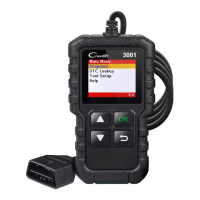LAUNCH
3001
User’s Manual
7
For some Asian and European vehicles, the DLC is located behind the ashtray
and the ashtray must be removed to access the connector. If the DLC cannot be
found, refer to the vehicle’s service manual for the location.
Figure 2-2
2.5 OBD 2 Terminology
The following terms and their definitions are related to OBD 2 systems. Read and
reference this list as needed to aid in the understanding of OBD 2 systems.
Powertrain Control Module (PCM)
-- The PCM is the OBD 2 accepted term for
the vehicle’s “on-board computer.” In addition to controlling the engine
management and emissions systems, the PCM also participates in controlling the
powertrain (transmission) operation. Most PCMs also have the ability to
communicate with other computers on the vehicle (ABS, ride control, body, etc.).
Monitors
-- Monitors are “diagnostic routines” programmed into the PCM. The
PCM utilizes these programs to run diagnostic tests, and to monitor operation of
the vehicle’s emissions-related components or systems to ensure they are
operating correctly and within the vehicle’s manufacturer specifications. Currently,
up to fifteen Monitors are used in OBD 2 systems. Additional Monitors will be
added as the OBD 2 system is further developed.
*Note: Not all vehicles support all fifteen Monitors.
Enabling Criteria
-- Also termed Enabling Conditions. They are the
vehicle-specific events or conditions that must occur within the engine before the
various monitors will set, or run. Some monitors require the vehicle to follow a
prescribed “drive cycle” routine as part of the enabling criteria. Drive cycles vary
among vehicles and for each monitor in any particular vehicle. Please refer to the
vehicle’s factory service manual for specific enabling procedures.
Trip
- A Trip for a particular Monitor requires that the vehicle is being driven in
such a way that all the required “Enabling Criteria” for the Monitor to run and

